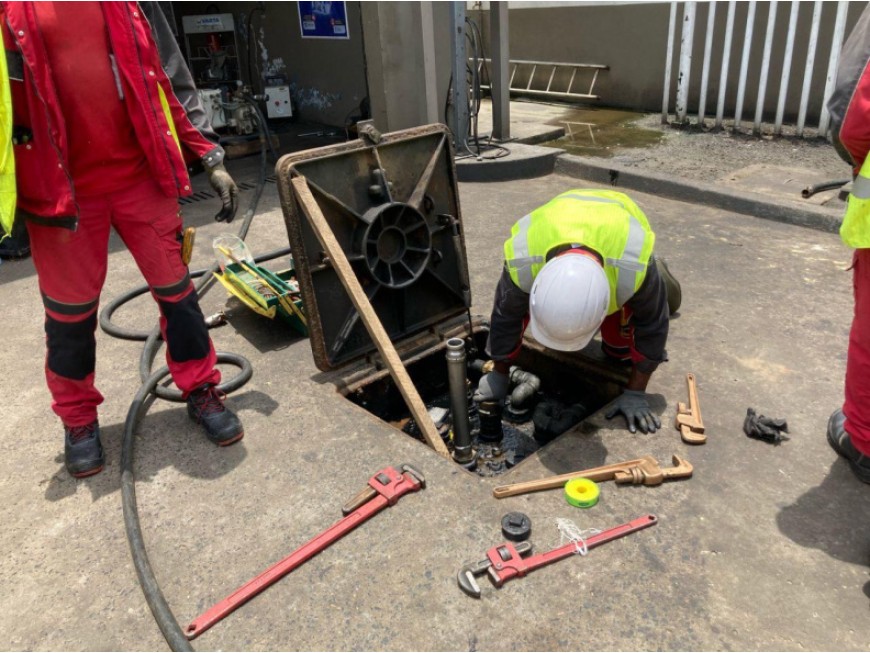Fuel Leaking From Domestic Underground Storage Tanks Damage the Environment and Waste Valuable Resources
Overtime the tightness integrity of underground storage tanks or other air tight compartments can deteriorate. Or… they were never air tight to begin with. This is why tightness testing is an essential maintenance task to be carried out on underground storage tanks to prevent leaks that are wasteful and harmful to the environment. Indeed, leaking underground storage tanks result in contamination of the surrounding soil, groundwater and surface water. Not to mention, the loss of resources through the leak.
Underground tank testing with ultrasound simultaneously evaluates the tightness of the tank and the piping without opening the manhole. The SDT device detects leaks in domestic underground fuel storage tanks thanks to the Guided Mode embedded in its firmware, escorting you through the standard procedure step-by-step. Use guided mode to add visual information useful for report creation such as the liquid level, the tank’s diameter, and much more.
The SDT Tank Test Reporter provides tank owners with a comprehensive report detailing their tank condition.
Tank tightness testing using ultrasound inspection is a reliable method for assessing the integrity and leak potential of storage tanks. It involves the use of specialized ultrasound equipment to detect and analyze ultrasound signals emitted by the tank structure. Here is an overview of how tank tightness testing using ultrasound inspection is typically done:
Equipment Preparation:
Ultrasound Device:
An ultrasound inspection device with a sensitive microphone or sensor specifically designed for tank inspections is used. The device may have adjustable settings to optimize the detection of ultrasound signals.
Sensor Placement:
The ultrasound sensor is attached to the tank surface at various predetermined measurement points. These points are typically located near known potential leak areas, such as seams, welds, joints, or penetrations.
Baseline Measurement:
Before the testing begins, a baseline measurement is taken. The ultrasound sensor is placed on the tank surface at each measurement point, and the background ultrasound signal is recorded. This provides a reference for comparison during subsequent measurements.
Tank Pressurization:
The tank is pressurized with a controlled amount of air or inert gas, usually using a low-pressure source. The pressure is gradually increased to a specified level, which is typically below the tank’s normal operating pressure but high enough to potentially reveal any leaks.
Ultrasound Signal Capture:
Once the tank is pressurized, the ultrasound inspection device is used to capture ultrasound signals emitted by the tank structure. The sensor is placed on each measurement point, and the ultrasound data is recorded.
Data Analysis:
The captured ultrasound signals are analyzed using specialized software or tools capable of processing and interpreting the data. The analysis focuses on detecting any anomalies or changes in the ultrasound signals that indicate the presence of leaks or structural weaknesses.
Leak Identification:
The analysis compares the recorded ultrasound signals to the baseline measurement taken earlier. Any significant deviations or increases in ultrasound activity indicate potential leaks or weaknesses in the tank structure.
Reporting and Evaluation:
A comprehensive report is generated based on the analysis results. The report includes information about the tank, measurement points, pressure levels, and any identified leaks or structural issues.
The report may also provide recommendations for repairs, further inspections, or additional testing based on the severity and location of the identified leaks or weaknesses.
Tank tightness testing using ultrasound inspection is a non-destructive and efficient method for evaluating the integrity of storage tanks. By detecting and analyzing ultrasound signals emitted by the tank structure, this testing method helps identify leaks, minimize environmental risks, and ensure the safety and reliability of tank systems.






